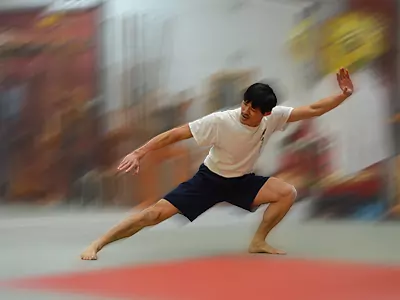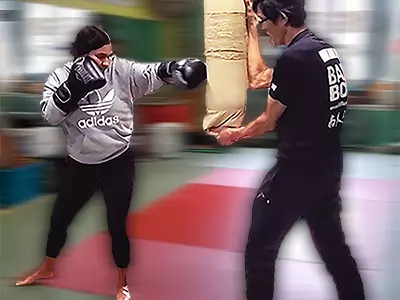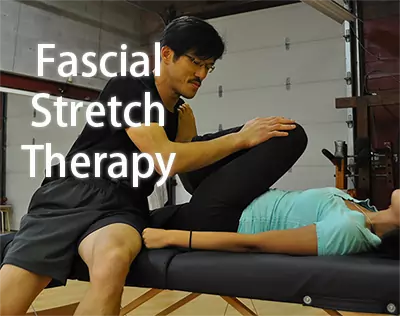Updated on April 12, 2022
Martial arts training

Martial art is an art form of self-defence used in real-world applications and in sports.
In today’s society, martial arts have been used as a form of physical training for improving health and wellness.
Personal Trainer Toronto's martial art program is a well-rounded physical training regimen for improving muscle tone, restoring musculoskeletal balance, increasing strength, flexibility, coordination, body awareness and an excellent way to help lose weight.
Our program is based on a traditional Chinese martial art style called Choy Li Fut kung fu.
Martial art coach
Our martial art coach, Kin Sze, is a lead kung fu instructor at Bamboo Kung Fu and a practising Registered Massage Therapist RMT. Kin Sze, is a highly experienced martial coach. He has 30 years of practice experience and 20 years of martial art coaching experience.
Negative effects of too much sitting
We spend most of our daily activities in the seated posture. We spend hours sitting in front of our computer or laptop while working, we sit while driving, we sit when we have meals with friends and family, etc.
Before we know it, various parts of our bodies weaken and become deconditioned. Our bodies need stimulation to maintain strength and functionality.
Day in day out of prolonged sitting and a sedentary lifestyle will cause our hip flexor muscles, which bend our hip forward, to become tight, while the gluteal muscles in the buttocks become weak and taut. At the same time, our lower back muscles become tight as well and our abs and oblique muscles are weakened.
The condition is called cross pelvic syndrome.
As such, we are prone to lower back injuries i.e., sciatica, slipped or herniated disk in the spine.
In the 21st century, one of the most prevalent malady causes is sitting. Sitting has become the new smoking.
Read more about our blog post: Why sitting causes lower back pain.
Proactive prehab
Our training approach is to resolve issues i.e., proactively prehab before you get injured from the physical training.
For example, if you have some issues with tight hip flexors that restrict your movements, we will customize a hip mobility program to address the issue before you get injured from strained muscles around your hip or much worse a chronic lower back injury.
Correct form and technique
We will focus on having you perform the techniques correctly in good alignment. We won’t have you mindlessly bash pads or do hundreds of repetitions of punching, kicking without understanding the technique/form. Appreciating the correct form and mindfully focusing on getting you to practice with good alignment and posture will help you to train more effectively and minimize injury risks.
Traditional Chinese martial arts’ core strength focus
Traditional Chinese martial arts have always placed strong emphasis on stance rooting. The technique will involve conditioning the abdominal and lower back groups of muscles.
What does rooting mean?
Rooting is the effect of having your feet “grip” the ground so you can effectively push or pull without losing balance. When done well, you’ll feel as if you’re rooted to the ground like a tree or your feet are glued to the ground.
Why is stance rooting important?
As discussed earlier, foundational kung fu training involves the practice of rooting.
Imagine trying to push a stiff heavy door open while you’re on a skateboard. Most likely, you’ll have to get off the skateboard and have your feet solidly rooted on the ground before you can push the door open. Not having a strong core, gluteal and leg muscles to stabilize your body while you are trying to execute some martial art techniques, is like having you try to punch a target while you are on a skateboard.
In order to get your balance rooted to the ground, you will need to simultaneously activate your lower back, abs, gluteal muscles, muscles of the thighs, calves, intrinsic muscles of the feet and toes so that your entire body can push diagonally downward into the ground. The stance rooting training is like doing a Pallof press together with a leg workout. The skill is physically challenging and requires focus and body control.
The concept of pushing your weight into the ground is to elicit an instantaneous equal and opposite reaction force which can be used to aid in propelling a strike with a punch or kick, to add to the distance of a forward lunge or to provide a stable grounding to push off for a sharp direction change of footwork cuts.
How does kung fu training program improve lower back health?
Martial art or kung fu training is a full-body workout. You will strengthen your arms from the punches and blocks, and improve leg strength from kicking, quick footwork steps. Apart from strengthening the body’s appendicular extremities, strength conditioning happens to the regions of the body in closest proximity to the body centre or the axial skeletal structures i.e., the gluteal region, upper back, lower back, abdominal and oblique muscles.
In fact, the key to every effective martial art hand technique is the transfer of rebounding energy from the ground up to through a stack of the kinetic chain from the legs, then to the gluteal muscles, through the lower back and abdominal/oblique muscles, then through the upper back muscles, further to the shoulder, and continue on through the brachium.
Read more about the topic: Stances - The Most Important Secret in Martial Arts Practice.
The axial mechanical loading stimulates the musculature along the path of the kinetic chain, therefore, strengthening the surrounding muscles.

Another important movement pattern that is applicable in kung fu training is trunk rotation. In particular, Choy Li Fut kung fu draws a lot of power of its techniques from trunk rotations, of course, over a solidly rooted stance.
When you train in Choy Li Fut kung fu, you will move in multiple planes of movement. As you progress further into the training you will be lighter in your steps, more agile and have the ability to negotiate around accidental slips, falls, ankle sprains, etc.
With the axial loading and rotation of the core abdominal and lower back muscles, your lower back will strengthen and see improvements in flexibility. So, your lower back is much stronger, you can prevent backaches and are less likely to get injured.
Transferable to activities of daily living
How do the techniques and conditioning learn in kung fu help in activities of daily living? Most the movements in martial arts are functional.
You can transfer the functional movements learnt from martial arts to physical movements in everyday life.
For example, with the ground rooting skills learnt from kung fu sessions, you can now apply the rooting skills while riding in the subway without losing your balance when the subway train accelerates or decelerates.
Another example, you can apply the skill of punching with the lean of the body to push open a stiff heavy door that you may encounter at your workplace.
You may be interested in:
Why sitting causes lower back pain

Why sitting causes lower back pain
Functional Fitness & Strength

Our team of personal trainers can provide personal training in multiple programs: weight training, kettlebells, Essentrics, dance-inspired programs, martial arts training in traditional kung fu, kickboxing.
With a Registered Massage Therapist RMT in our team, Personal Trainer Toronto, has the capability to provide full-body assessments and prescribe therapeutic exercises.
More-about Functional Strength and Fitness programs
Kickboxing training

Kickboxing is a whole-body workout regimen that uses combinations of punching and kicking techniques
Fitness kickboxing is effective in training your core strength, improves stamina, better muscle tone.
The program is a combination of high-intensity interval training (HIIT) and aerobic training which is good for improving stamina.
Essentrics™-Dynamic stretching, strengthening

Essentrics™ is a dynamic stretching, strengthening program. The program is ideal for increasing mobility, range of motion (ROM), stress relief, relax tensed muscles.
More-about Essentrics™ program
Massage Therapy RMT

Our massage therapy sessions are provided by a Registered Massage Therapist RMT. Massage therapy treatments help to release stiffness in muscles, adhesions aka knots, aches and pains, joints stiffness.
If you have workplace health benefits or extended health coverage, you can offset the cost of the massage therapy sessions.
Fascial Stretch Therapy

Fascial Stretch Therapy is a stretching system developed by Stretch to Win. Elite athletes of NFL, NBA, NHL, martial artists and dancers have benefitted from the fascial stretching system to improve their game.
Fascial Stretch Therapy is a form of myofascial stretching therapy.